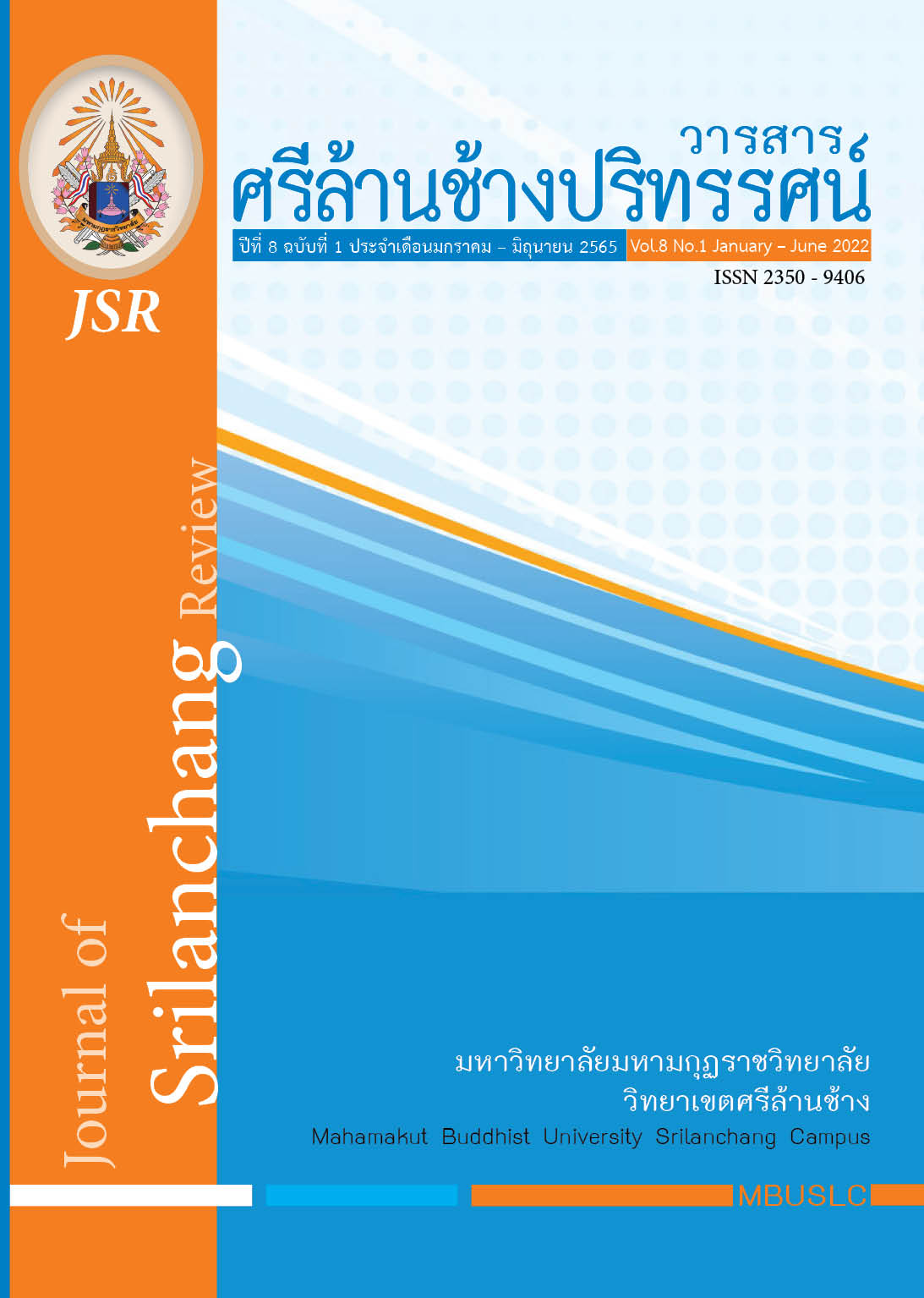AUTHORING TECHNIQUES AND BUDDHIST CONCEPTS IN NORRARAT RAKDEE’S MORAL NOVEL OF “RAK AN TA RAI”
Main Article Content
Abstract
The objective of the academic article was to study the authoring techniques and Buddhist concepts in the morality-oriented alternative novel “Rak An Ta Rai” (Dangerous Love), written by Norrarat Rakdee. The literary analysis techniques and concepts, based on structuralism and Buddhism, were used as the conceptual framework to study six components: 1) Reality – the reality was found in the contemporary language usage in terms of English transliterated words (Borrowed words) in the description or the dialogue. 2) Roles – main actor and actress, including significant characters, were characterized by gentleness and politeness without weakness. It reflected the dynamics of those characters on the situations concerning the cultural surrounding context of Thai people in the past. 3) Idealism – the significant characters were found to develop the countryside with knowledge on farming and cropping. The rural waste land was changed into the complete source of agricultural crop production. 4) Setting - the setting was described in detail to have the readers profoundly understand the novel’s crux. The idiomatic explanation was used to illustrate colorful images reflecting the emotions and surroundings of the rural area. 5) Style – the specific writing style and art was remarkably used to demonstrate reality, beauty and calm. 6) Buddhist Concept – the Buddhism-oriented concept conveyed the Buddhist principles: belief in Karma (the law of action) and transmigration. Besides, historical story in the Buddha’s period was found to entertain the readers in the literature and the principle of living life.
Article Details

This work is licensed under a Creative Commons Attribution-NonCommercial-NoDerivatives 4.0 International License.
บทความที่ได้รับการพิจารณาจากคณะกรรมการผู้ทรงคุณวุฒิและเผยแผ่ในวารสารฉบับนี้ เป็นทัศนคติและข้อคิดเห็นส่วนบุคคลของผู้เขียนแต่ละท่าน ไม่ถือว่าเป็นทัศนะคติและความรับผิดชอบ
ของบรรณาธิการ
บทความ ข้อมูล เนื้อหา รูปภาพ ฯลฯ ที่ได้รับการตีพิมพ์ในวารสารศรีล้านช้างปริทรรศน์ ถือเป็นลิขสิทธิ์ของวารสารศรีล้านช้างปริทรรศน์ หากบุคคลหรือหน่วยงานใดต้องการนำทั้งหมดหรือส่วนหนึ่งส่วนใดไปเผยแพร่ต่อหรือเพื่อกระทำการใด ๆ จะต้องได้รับอนุญาตเป็นลายลักอักษรจากวารสารศรีล้านช้างปริทรรศน์ ก่อนเท่านั้น
References
กิตติยา คุณารักษ์ และคณะ. (2564). อำนาจผี บารมีพุทธ: ความเชื่อเชิงอุดมการณ์ทางศาสนาในนวนิยายจินตนิยมเรื่องมิติที่สาม. วารสารบัณฑิตสาเกตปริทรรศน์. 6(2). กรกฎาคม-ธันวาคม.
ดวงมน จิตร์จำนงค์. (2561). หลังม่านวรรณกรรม. (พิมพ์ครั้งที่ 2). นนทบุรี: สำนักพิมพ์สัมปชัญญะ.
ธัญญา สังขพันธานนท์. (2539). วรรณกรรมวิจารณ์. กรุงเทพฯ : สำนักพิมพ์นาคร.
นรรัตน์ รักดี. (2564). รักอันตราย. เลย: บจก.รุ่งแสงธุรกิจการพิมพ์.
นิธิ เอียวศรีวงศ์. (2555). ปากไก่และใบเรือ: รวมความเรียงว่าด้วยวรรณกรรมและประวัติศาสตร์ต้นรัตนโกสินทร์. (พิมพ์ครั้งที่ 4). นนทบุรี: สำนักพิมพ์ฟ้าเดียวกัน.
บุญเหลือ โจมโน. (2556). ภาษาบาลีสันสกฤตในภาษาไทย. กรุงเทพฯ : สำนักพิมพ์แดเน็กซ์ อินเตอร์.
พระณัฐวุฒิ มหาวิริโย (ก้อนจา) และคณะ. (2563). ศึกษาเชิงวิเคราะห์หลักพุทธธรรมที่ปรากฏในธรรมนิยายเรื่องลีลาวดี. วารสารพุทธศาสตร์ศึกษา. 11(2). กรกฎาคม – ธันวาคม.
พระมหาสุริยา อภิวฑฺฒโน (มะสันเทียะ). (2563). การเผยแผ่พระพุทธศาสนาตามหลักโอวาทปาติโมกข์ : หลักการ อุดมการณ์และวิธีการ. วารสาร มจร มนุษยศาสตร์ปริทรรศน์, 6(1), 4-5. มกราคม-มิถุนายน.
มารศรี สอทิพย์ และสุทธภา อินทรศิลป์. (2562). การเล่าเรื่องและอุดมการณ์ในนวนิยายเพื่ออาเซียนกรณีศึกษา รักในม่านฝน. สารอาศรมวัฒนธรรมวลัยลักษณ์. 19(1). มกราคม-มิถุนายน.
รื่นฤทัย สัจจพันธุ์ (บรรณาธิการ). (2560). ทฤษฏีกับการวิจารณ์ศิลปะ: ทัศนะของนักวิชาการไทย. ปทุมธาณี: สำนักพิมพ์นาคร.
รื่นฤทัย สัจจพันธุ์. (2561). นัยในวรรณกรรม. กรุงเทพฯ: สำนักพิมพ์แสงดาว.
วัฒนา มุลเมืองแสน, (2539). นวนิยายอิงพุทธศาสนาของไทย : วรรณกรรมคำสอนร่วมสมัย. วิทยานิพนธ์ (อ.ม.) จุฬาลงกรณ์มหาวิทยาลัย.
อิราวดี ไตลังคะ. (2543). ศาสตร์และศิลป์แห่งการเล่าเรื่อง. กรุงเทพฯ: สำนักพิมพ์มหาวิทยาลัยเกษตรศาสตร์.


